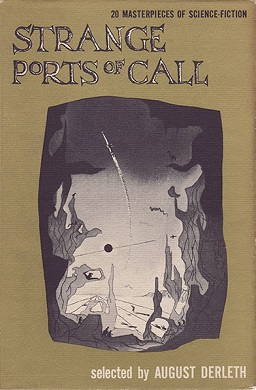
Amazing Stories, September 1928 cover, featuring the winning entry in a contest to design an emblem for "scientifiction" - http://www.luminist.org/archives/SF/AS.htm
 The Best of Science Fiction
by
The Best of Science Fiction
by
 Strange Ports of Call
by
Strange Ports of Call
by
 Before the Golden Age : a science fiction anthology of the 1930s
by
Before the Golden Age : a science fiction anthology of the 1930s
by
 Great Tales of the Golden Age of Science Fiction
by
Great Tales of the Golden Age of Science Fiction
by
Librarian's note: Four of the books listed in this box were written by women speculative fiction authors. Can you tell which ones they are?
 The Skylark of Space
by
The Skylark of Space
by
 The Humanoids
by
The Humanoids
by
 The Best of Stanley G. Weinbaum
by
The Best of Stanley G. Weinbaum
by
 The Star Maker
by
The Star Maker
by
 Lest Darkness Fall
by
Lest Darkness Fall
by
 Triad : three complete science fiction novels [The world of A.--The voyage of the space beagle.--Slan.]
by
Triad : three complete science fiction novels [The world of A.--The voyage of the space beagle.--Slan.]
by
 The Past Through Tomorrow: Future History Stories
by
The Past Through Tomorrow: Future History Stories
by
 City
by
City
by
 Valley of the Flame
by
Valley of the Flame
by
 Shadow on the Hearth
by
Shadow on the Hearth
by
 The city and the stars
by
The city and the stars
by
 The Dying Earth
by
The Dying Earth
by
 The Martian Chronicles
by
The Martian Chronicles
by
This work is licensed under CC BY-NC-SA 4.0